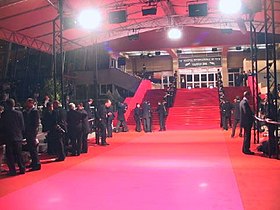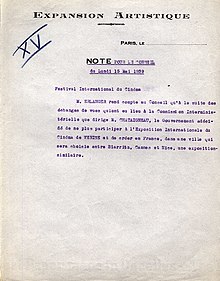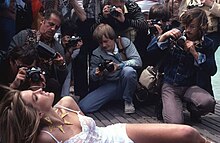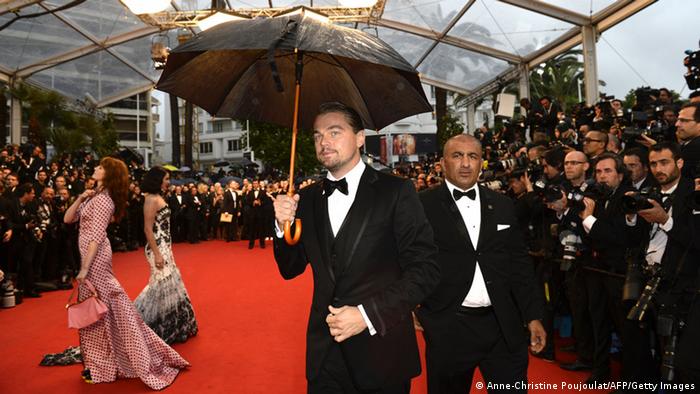
مهرجان كان السينمائي

إحداثيات: 43°33′03.10″N 7°01′02.10″E
| مهرجان كان السينمائي | |
|---|---|
|
السجادة الحمراء حيث يسير عليها مشاهير السينما في العالم
|
|
|
|
|
| الاسم | مهرجان كان السينمائي |
|
|
|
| الموقع الرسمي | festival-cannes.com |
مهرجان كان السينمائي (بالفرنسية: Festival de Cannes), هو أحد أهم المهرجانات السينمائية عبر العالم.[1][2][3] يرجع تأسيسه إلى سنة 1946. وهو يقام كل عام عادة في شهر مايو، في مدينة كان في جنوب فرنسا. يوزع المهرجان عدة جوائز أهمها جائزة السعفة الذهبية لأفضل فيلم. مركز إقامته قصر المهرجانات في شارع لاكروازييت الشهير على سواحل خليج كان اللازوردية.
تاريخ المهرجان
انطلقت الدورة الأولى من المهرجان في مدينة كان الفرنسية في اليوم الأول من شهر سبتمبر عام 1939. ولم يكد المهرجان يدخل يومه الثالث حتى نشبت معركة حربية بين فرنسا وبريطانيا من جهة وبين ألمانيا من جهة أخرى، ما أدى إلى تأجيل المهرجان وتعليقه إلى أجل غير مسمى؛ نظراً لظروف الحرب الدائرة.
تطورت المناوشات الحربية الدائرة بين فرنسا وألمانيا إلى احتلال ألماني لجزء من الأراضي الفرنسية؛ ما قضى على أي أمل قريب في أن يستكمل المهرجان بدايته المتواضعة التي لم تتجاوز من العمر يومين اثنين! وكما هو معلوم تطورت تلك الحرب واستمرت لتكون ما عرف فيما بعد بالحرب العالمية الثانية التي وضعت أوزارها نهاية العام 1945.
ولم يكن من المنطقي حينها أن تطرح فكرة إعادة تفعيل مهرجان سينمائي، لذا احتاج الأمر إلى سنة ليعود بعدها المهرجان للظهور من جديد في منتصف عام 1946، الذي يشكل الانطلاقة الحقيقية لمهرجان كان السينمائي.
لم يلبث المهرجان أن أعيد إطلاقه من جديد حتى توقف في دورة عام 1948، ثم توقف مرة أخرى في دورة عام 1950 وذلك لظروف تمويلية مادية، ومنذ انطلاقة المهرجان بعد ذلك لم يحدث أن توقف سوى دورة واحدة سنة 1968.
حضور سينمائي كبير
يتميز مهرجان كان السينمائي بالحضور السينمائي الكبير والمتنوع الذي يرافقه، فلا يلتقي هذا الكم من السينمائيين من جميع أنحاء العالم في وقت واحد كما يحصل في مدينة كان خلال المهرجان.
كما أنه يتميز بالتجديد والقدرة على مواكبة الموجات الفنية الجديدة، بل ودعمها، وربما خلقها في رحم المهرجان وأروقة الدورات المقامة.
كما يتميز المهرجان كذلك بتنوع جوائزه من عام لآخر مع استقرار الجوائز الأصلية للمهرجان، وهي:
- السعفة الذهبية: وتمنح هذه الجائزة لأفضل فيلم في الدورة على الإطلاق بحسب تقييم لجنة التحكيم.
- الجائزة الكبرى: لأفضل فيلم (تختلف عن السعفة في كونها تعبر عن رأي لجنة التحكيم الخاص، ولا تخضع بالضرورة للمعايير السينمائية العامة).
- جائزة لجنة التحكيم.
- جائزة أفضل إخراج.
- جائزة أفضل سيناريو.
- جائزة أفضل ممثل.
- جائزة أفضل ممثلة.
- جائزة أفضل فيلم قصير.
- جائزة لجنة التحكيم لأفضل فيلم قصير.
ما عدا ذلك من الجوائز، والتي تتجاوز في بعض الدورات العشرين جائزة، فهي إما تتبع للجان وجمعيات سينمائية مختصة تمنح جائزتها عبر المهرجان، أو تكون موسمية غير دورية بحيث يرافقها مناسبة سينمائية خاصة.
وتمر عملية فرز الأفلام المرشحة لهذه الجوائز عبر مرشحات فنية دقيقة، حيث يتزايد عدد الأفلام المقدمة للمهرجان سنويًّا عن ألفي فيلم بقليل. وتقوم لجان مشاهدة متخصصة بفرزها والوصول بها إلى اثنين وعشرين فيلماً متنافساً فقط، يشترط فيها أن تعرض في المهرجان عرضاً عالميًّا أولًا.
فعاليات سينمائية كبيرة
ولا يقتصر دور مهرجان كان السينمائي على استضافة وعرض الأفلام المرشحة، بل يتجاوز ذلك بكثير من خلال إقامته لعديد من الفعاليات السينمائية المتزايدة كل عام، والتي تضمن عرض عدد كبير من الأفلام السينمائية من خلال تظاهرات عدة من أبرزها:
- أسبوع النقاد : وهو تظاهرة فنية تعنى باختيار أبرز أفلام السنة السينمائية من خلال جمعية نقاد معينة، وعرضها خلال فترة المهرجان لإتاحة الفرصة للمهتمين السينمائيين لمشاهدتها.
- نصف شهر المخرجين : وهي تظاهرة فنية تعنى باختيار أفلام سينمائية من قبل جمعية مخرجي سينمائيين.
- سوق الفيلم : وهي مجموعة من الصالات السينمائية التي تعنى بتسويق المنتجين والموزعين لأفلامهم من خلال دفع مبلغ مالي مقابل عرض الفيلم – بغض النظر عن مستواه الفني أو النقدي – خلال فترة عرض المهرجان اغتناماً لفرصة وجود عدد كبير من المهتمين السينمائيين العالميين.
- ركن الأفلام القصيرة : ويهتم هذا الركن بعرض الأفلام القصيرة من جميع أنحاء العالم، ويركز بشكل أساس على الأفلام التي تم استبعادها من اختيار لجان المشاهدة في مراحل التصفيات.
- سينما العالم : وهي تظاهرة سنوية تعنى باختيار نماذج مميزة من سينما إحدى الدول غير المشهورة سينمائيًّا، وعرض أفلامها لجمهور المهتمين السينمائيين.
يضاف إلى ما سبق ذكره من فعاليات وعروض سينمائية، كثير من الفعاليات السينمائية التي تصاحب المهرجان خلال فترة إقامته، ما يجعله وبجدارة العرس السينمائي الأبرز حول العالم، والذي ينتظره جمهور السينما بفارغ الصبر كل عام.
نتائج السعفة الذهبية
الجائزة الكبرى لمهرجان كان (1946-1954)[عدل]
السعفة الذهبية (1955-الآن)[عدل]
الفائزون أكثر من مرة
سبعة مخرجين تحصلوا على جائزة السعفة الذهبية أكثر من مرة وهم:
- بيل أوغوست: بيل الفاتح (1988) وأفضل النوايا (1992).
- فرانسيس فورد كوبولا: المحادثة (1974) والقيامة الآن (1997).
- الإخوة دردان: روزيتا (1999) والطفل (2005).
- مايكل هاينيكي: الشريط الأبيض (2009) والحب (2012).
- إيمامورا شوهيه: قصة ناراياما (1983) وثعبان البحر (1997).
- أمير كوستوريتسا: أبي في رحلة عمل (1985) وتحت الأرض (1995).
- الف سوبيرغ: إريس وقلب الملازم (1946) والآنسة جولي (1951).
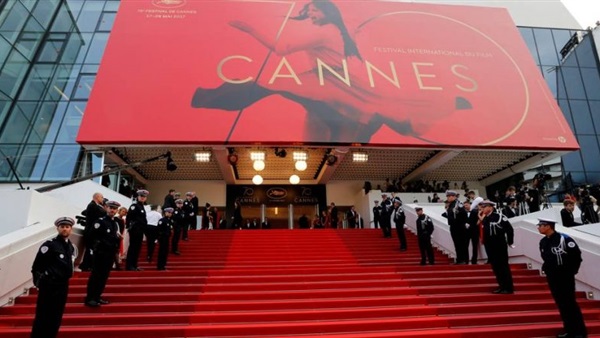
Cannes Film Festival
Jump to navigationJump to search
 |
|
 |
|
| Location | Cannes, France |
|---|---|
| Founded | 20 September 1946 (as International Film Festival) |
| Awards | Palme d’Or, Grand Prix |
| Website | www |

Cannes seen from Le Suquet
The Cannes Festival (/kæn/; French: Festival de Cannes), until 2003 called the International Film Festival (Festival international du film) and known in English as the Cannes Film Festival, is an annual film festival held in Cannes, France, which previews new films of all genres, including documentaries from all around the world. Founded in 1946, the invitation-only festival is held annually (usually in May) at the Palais des Festivals et des Congrès.[1]
On 1 July 2014, co-founder and former head of French pay-TV operator Canal+, Pierre Lescure, took over as President of the Festival, while Thierry Frémaux became the General Delegate. The board of directors also appointed Gilles Jacob as Honorary President of the Festival.[2][3]
Is one of the “Big Three” film festivals, alongside the Venice Film Festival and Berlin International Film Festival.[4][5] The Big Three are internationally acclaimed for giving creators the artistic freedom to express themselves through film.[6] In 1951, FIAPF formally accredited the festival.[7]
The early years
The Cannes Film Festival has its origins in 1938 when Jean Zay, the French Minister of National Education, on the proposal of high-ranking official and historian Philippe Erlanger and film journalist Robert Favre Le Bret decided to set up an international cinematographic festival. They found the support of the Americans and the British.
Its creation can be largely attributed to the French desire to compete with the Venice Film Festival, which at the time was the only international film festival and had shown a lack of impartiality with its fascist bias during those years.[8] The political interference seemed evident in the 1937 edition when Benito Mussolini meddled to ensure that French pacifist film La Grande Illusion would not win.[9]
The last straw was in the 1938 event when Mussolini and Adolf Hitler respectively overruled the jury’s decision in order to award the Coppa Mussolini (Mussolini Cup) for the Best film to Italian war film Luciano Serra, Pilot, produced under the supervission of Mussolini’s son, and the Coppa Mussolini for the Best foreign film to Olympia, a German documentary film about the Berlin 1936 Summer Olympics produced in association with the Nazi Ministry of Public Enlightenment and Propaganda despite the fact that the regulations at that time prohibited awarding a documentary.
Outraged by the decision and as a measure of protest, the French, British, and American jury members decided to withdrew from the festival with the intention of not returning.[10] This snub encouraged the French to found a free festival. Thus, on May 31, 1939, the city of Cannes was finally selected as the location for the festival over Biarritz and the town hall along with the French government signed the International Film Festival’s official birth certificate with the name of Le Festival International du Film.[11]
The reason for deciding Cannes was because of its touristic appeal as a French Riviera resort town and also because the city hall offered to increase the municipality’s financial participation, including the commitment of building a dedicated venue for the event. The first edition was planned to be held from 1 to 20 September 1939 in an auditorium at the Municipal Casino and Louis Lumière was going to be the honorary president. Its aim was “encouraging the development of all forms of cinematographic art and foster a spirit of collaboration between film-producing countries”.[10]
Hollywood stars of the moment like Gary Cooper, Cary Grant, Tyrone Power, Douglas Fairbanks Jr., Mae West, Norma Shearer, Paul Muni, James Cagney, Spencer Tracy, and George Raft arrived thanks to a Ocean liner chartered by the Metro-Goldwyn-Mayer (MGM). On 31 August, the opening night gala took place with the private screening of the American film The Hunchback of Notre Dame starring Charles Laughton and Maureen O’Hara and directed by William Dieterle. The next day, on September 1, German troops invaded Poland. As a result, the festival was postponed for 10 days and it would be resumed if the circumstances allowed it.[11] However, the situation only worsened and on September 3, France and the United Kingdom declared the war against Germany which sparked the Second World War. The French government ordered a general mobilization and this prevented the festival from continuing so it was finally cancelled.[12]
In 1946, the festival was relaunched and from 20 September to 5 October, 1946, twenty-one countries presented their films at the First Cannes International Film Festival, which took place at the former Casino of Cannes.[13] In 1947, amid serious problems of efficiency, the festival was held as the “Festival du film de Cannes”, where films from sixteen countries were presented. The festival was not held in 1948 and 1950 due to budgetary problems.
In 1949, the Palais des Festivals was expressly constructed for the occasion on the seafront promenade of La Croisette, although its inaugural roof, while still unfinished, blew off during a storm. In 1951, the festival was moved to spring to avoid direct competition with the Venice Festival which was held in autumn.[12]
1950s and 1960s
During the early 1950s, the festival attracted a lot of tourism and press attention, with showbiz scandals and high-profile personalities’ love affairs. At the same time, the artistic aspect of the festival started developing. Because of controversies over the selection of films, the Critics’ Prize was created for the recognition of original films and daring filmmakers. In 1954, the Special Jury Prize was awarded for the first time. In 1955, the Palme d’Or was created, replacing the Grand Prix du Festival which had been given until that year. In 1957, Dolores del Río was the first female member of the jury for the official selection.[14]
In 1959, the Marché du Film (Film Market) was founded, giving the festival a commercial character and facilitating exchanges between sellers and buyers in the film industry. Today it has become the first international platform for film commerce. Still, in the 1950s, some outstanding films, like Night and Fog in 1956 and Hiroshima, My Love in 1959 were excluded from the competition for diplomatic concerns. Jean Cocteau, three times president of the jury in those years, is quoted to have said: “The Cannes Festival should be a no man’s land in which politics has no place. It should be a simple meeting between friends.”[15][16]
In 1962, the International Critics’ Week was born, created by the French Union of Film Critics as the first parallel section of the Cannes Film Festival. Its goal was to showcase first and second works by directors from all over the world, not succumbing to commercial tendencies. In 1965 Olivia de Havilland was named the first female president of the jury, while the next year Sofia Loren became president.[17]
The 1968 festival was halted on 19 May. Some directors, such as Carlos Saura and Miloš Forman, had withdrawn their films from the competition. On 18 May filmmaker Louis Malle along with a group of directors took over the large room of the Palais and interrupted the projections in solidarity with students and labour on strike throughout France,[18] and in protest to the eviction of the then President of the Cinémathèque Française. The filmmakers achieved the reinstatement of the President, and they founded the Film Directors’ Society (SRF) that same year.[19] In 1969 the SRF, led by Pierre-Henri Deleau created the Directors’ Fortnight (Quinzaine des Réalisateurs), a new non-competitive section that programs a selection of films from around the world, distinguished by the independent judgment displayed in the choice of films.[20]
1970s and 1980s
During the 1970s, important changes occurred in the Festival. In 1972, Robert Favre Le Bret was named the new President, and Maurice Bessy the General Delegate. He introduced important changes in the selection of the participating films, welcoming new techniques, and relieving the selection from diplomatic pressures, with films like MASH, and later Chronicle of the Years of Fire marking this turn. In some cases, these changes helped directors like Tarkovski overcome problems of censorship in their own country.[21] Also, until that time, the different countries chose the films that would represent them in the festival. Yet, in 1972, Bessy created a committee to select French films, and another for foreign films.[22]
In 1978, Gilles Jacob assumed the position of General Delegate, introducing the Caméra d’Or award, for the best first film of any of the main events, and the Un Certain Regard section, for the non-competitive categories. Other changes were the decrease of length of the festival down to thirteen days, thus reducing the number of selected films; also, until that point the Jury was composed by Film Academics, and Jacob started to introduce celebrities and professionals from the film industry.[23]
In 1983, a new, much bigger Palais des Festivals et des Congrès was built to host the festival, while the Directors’ Fortnight remained in the old building. The new building was nicknamed “The Bunker”, provoking a lot of criticism, especially since it was hardly finished at the event and several technical problems occurred.[24] In 1984 Pierre Viot replaced Robert Favre Le Bret as President of the Festival.[25] In his term, the Festival started including films from more countries, like Philippines, China, Cuba, Australia, India, New Zealand and Argentina. In 1987, for the first time of the Festival, a red carpet was placed at the entrance of the Palais. In 1989, during the first Cinéma & liberté forum, hundred directors from many countries signed a declaration “against all forms of censorship still existing in the world”.[26]
1990s to present
In 1998, Gilles Jacob created the last section of the Official Selection: la Cinéfondation, aiming to support the creation of works of cinema in the world and to contribute to the entry of the new scenario writers in the circle of the celebrities.[27] The Cinéfondation was completed in 2000 with La Résidence, where young directors could refine their writing and screenplays, and in 2005 L’Atelier, which helps twenty directors per year with the funding of their films. Gilles Jacob was appointed Honorary President in 2000, and in 2002, the Festival officially adopted the name Festival de Cannes.[28][29]
During the 2000s, the Festival started focusing more on the technological advances taking place in the film world, especially the digital techniques. In 2004 the restored historical films of the Festival were presented as Cannes Classics, which included documentaries. In 2007 Thierry Frémaux became General Delegate. In 2009 he extended the Festival in Buenos Aires, as La Semana de Cine del Festival de Cannes, and in 2010 he created the Cannes Court Métrage for the Short Film competition.
On March 20th 2020, organizers announced the postponement of the Cannes Film Festival 2020 due to the coronavirus global health crisis.[30] Spike Lee, director of “Do The Right Thing” and “BlacKkKlansman,” had been chosen to the lead the jury panel. In 2019, the jury panel was lead by Alejandro González Iñárritu, director of “Birdman”.[31]
Controversies
In recent years, a number of gender and sexual controversies has surrounded the Cannes Film Festival. These include “Heelgate” in which numerous female attendees of a red carpet premiere were stopped from entering in 2015 for wearing flat soled shoes instead of high heels.[32] The incident caused numerous female celebrities to wear flat soled shoes or no shoes at all to other red carpet premiers in a show of solidarity and protest.[33]
A number of high-profile directors and producers have also been accused of sexual harassment and abuse at past festivals.[citation needed]
As a result of the past sexual controversies and the #MeToo movement that arose out of the Harvey Weinstein scandal, in 2018, Cannes Film Festival officials announced the creation of a telephone hotline during the festival in which victims could report incidents of sexual harassment and other crimes.[34] The hotline is in collaboration with the French government.[35]
General Delegate Thierry Frémaux reportedly ‘banned’ selfies on the red carpet of the festival back in 2015.[36]
In 2017, along with the 70th anniversary events of the Festival, the issue of changing the rules on theatrical screening caused controversy.[37] In 2018, the enforcement of theatrical screening in France resulted in Netflix withdrawing their films from the festival.[38]
Festival team
|
This section needs additional citations for verification. (September 2017) (Learn how and when to remove this template message)
|
| Year | President | General Delegate | General Secretary | |
|---|---|---|---|---|
| 1949 | – | – | Jean Touzet | |
| 1952 | Robert Favre Le Bret | |||
| 1972 | Robert Favre Le Bret |
Maurice Bessy | ||
| 1978 | Gilles Jacob | |||
| 1984 | Pierre Viot | |||
| 1985 | Michel P. Bonnet | |||
| 1991 | François Erlenbach |
|||
| 2001 | Gilles Jacob | General Director Véronique Cayla |
Artistic Delegate Thierry Frémaux |
|
| 2005 | Catherine Démier | |||
| 2007 | Thierry Frémaux | |||
| 2014 | Pierre Lescure | |||
| 2017 | ||||
The President of the Festival, who represents the Festival in front of financial partners, the public authorities and the media, is elected by the board of directors of the Festival, officially named the “French Association of the Film Festival”.
The Board is composed of authorities of the world of cinema, as well as of public authorities which subsidize the event. The President has a renewable 3-year mandate and appoints the members of his team, including the General Delegate, with the approval of the board of directors.[39] Sometimes a President, after his last term, becomes the Honorary President of the Festival.
The General Delegate is responsible for the coordination of the events. When Gilles Jacob passed from General Delegate to the position of the President, in 2001, two new positions were created to take over his former post, the General Director to oversee the smooth running of the event, and the Artistic Director, responsible for the selection of films. However, in 2007, the Artistic Director Thierry Frémaux, became again the General Delegate of the Festival.
The general secretary is responsible for the reception of works and other practical matters.
Programmes
The Cannes Film Festival is organised in various sections:[40]
- The Official Selection – The main event of the festival.
- In Competition – The films competing for the Palme d’Or. They are projected in the Théâtre Lumière.
- Un Certain Regard – Films selected from cultures near and far; original and different works. They are projected at the Salle Debussy.
- Out of Competition – These films are also projected in the Théâtre Lumière but do not compete for the main prize.
- Special Screenings – The selection committee chooses for these films an environment specially adapted to their particular identity.
- Cinéfondation – About fifteen shorts and medium-length motion pictures from film schools over the world are presented at the Salle Buñuel.
- Short Films – The shorts competing for the Short Film Palme d’Or are presented at Buñuel and Debussy theatres. There are approximately 10 films in this competition.
- Cannes Classics – It celebrates the heritage of film, aiming to highlight works of the past, presented with brand new or restored prints.
- Cinéma de la Plage – Screening of Cannes Classics and Out of Competition films for the mass public on Macé beach, preceded by a programme dedicated to film music.
- Parallel Sections – These are alternative programmes dedicated to discovering other aspects of cinema.
- International Critics’ Week – Since 1962, it has focused on discovering new talents and showcasing first and second feature films by directors from all over the world.
- Directors’ Fortnight – Since 1969, it has cast its lot with the avant-garde, even as it created a breeding ground where the Cannes Festival would regularly find its prestigious auteurs.
- ACID (Association for Independent Cinema and its Distribution)
- Tous les Cinémas du Monde – It showcases the vitality and diversity of cinema across the world. Each day, one country is invited to present a range of features and shorts in celebration of its unique culture, identity and recent film works.
- Events
- Marché du Film – The busiest film market in the world.
- Masterclasses – Given in public by world-renowned filmmakers.
- Tributes – Honors internationally renowned artists with the presentation of the Festival Trophee following the screening of one of their films.
- Producers Network – An opportunity to make international co-productions.
- Exhibitions – Each year, an artist, a body of work or a cinematographic theme becomes the focus of an exhibition that diversifies or illustrates the event’s programme.
- 60th Anniversary – Events organised in 2007 dedicated to the 60th anniversary of the Festival.
Juries
Prior to the beginning of each event, the Festival’s board of directors appoints the juries who hold sole responsibility for choosing which films will receive a Cannes award. Jurors are chosen from a wide range of international artists, based on their body of work and respect from their peers.[41] The appointment of the President of the Jury is made following several annual management proposals made in the fall and submitted to the Festival’s board of directors for validation.[42]
- Feature Films – An international jury composed of a President and various film or art personalities, who determine the prizes for the feature films in Competition.
- Cinéfondation and Short Films – Composed of a President and four film personalities. It awards the Short Film Palme d’Or as well as the three best films of the Cinéfondation.
- Un Certain Regard – Composed of a President, journalists, students in cinema, and industry professionals. It awards the Un Certain Regard Prize for best film and can, moreover, honour two other films.
- Caméra d’Or – Composed of a President, as well as film directors, technicians, and French and international critics. They award the best film in any category.
The jury meets annually at the historic Villa Domergue to select the winners.[43]
Awards

Palme d’Or awarded to Apocalypse Now at the 1979 Cannes Film Festival

In 2013, Adèle Exarchopoulos and Léa Seydoux became the first and only cast members to receive the Palme d’Or for Blue Is the Warmest Colour in an “unprecedented move”, alongside the director Abdellatif Kechiche.
The most prestigious award given at Cannes is the Palme d’Or (“Golden Palm”) for the best film.
- Competition
- Palme d’Or – Golden Palm
- Grand Prix – Grand Prize of the Festival
- Prix du Jury – Jury Prize
- Palme d’Or du court métrage – Best Short Film
- Prix d’interprétation féminine – Best Actress
- Prix d’interprétation masculine – Best Actor
- Prix de la mise en scène – Best Director
- Prix du scénario – Best Screenplay
- Other Sections
- Prix Un Certain Regard – Young talent, innovative and audacious works
- Cinéfondation prizes – Student films
- Caméra d’Or – It rewards the best first film of the Festival, choosing among the debutants’ works among the Official Selection, the Directors’ Fortnight and the International Critics’ Week selections.
- Given by Independent Entities
- FIPRESCI Prize – The International Federation of Film Critics awards prizes to films from the main competition section, Un Certain Regard and parallel sections
- Directors’ Fortnight Prizes
- Prix Vulcain – Awarded to a technical artist by the CST
- International Critics’ Week Prizes
- Prize of the Ecumenical Jury
- François Chalais Prize
- L’Œil d’or – Best documentary film
- Trophée Chopard
- Palm Dog – Best canine performance[44]
- Queer Palm – Best LGBT-related films[45]
- Cannes Soundtrack Award
- Pierre Angénieux Excellens in Cinematography
Impact
The festival has become an important showcase for European films. Jill Forbes and Sarah Street argue in European Cinema: An Introduction (ISBN 0333752104), that Cannes “became…extremely important for critical and commercial interests and for European attempts to sell films on the basis of their artistic quality” (page 20).[46] Forbes and Street also point out that, along with other festivals such as the Venice Film Festival and Berlin International Film Festival, Cannes offers an opportunity to determine a particular country’s image of its cinema and generally foster the notion that European cinema is “art” cinema.[46]
Additionally, given massive media exposure, the non-public festival is attended by many stars and is a popular venue for film producers to launch their new films and to attempt to sell their works to the distributors who come from all over the globe.
Cannes Film Festival in fiction
Though most of the media attention the festival receives is journalistic in nature, the festival has been explored from the standpoint of fiction by novelists over the years.
J. G. Ballard’s Super-Cannes is about the European elite who live in a closed society by the festival. Michael Grothaus’ Epiphany Jones is a social satire about the festival and film industry and explores sex trafficking that occurs during the festival. The book was named one of the best Hollywood novels of all time by Entertainment Weekly.[47] Iain Johnstone’s Cannes: The Novel is a dystopian tale about terrorists holding the festival hostage.
In addition to fictional works, the festival has been examined in contexts ranging from the cultural to the historical in a host of non-fiction books.[48]




